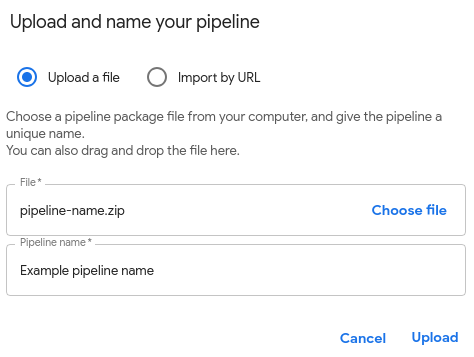Deploying a pipeline
The machine learning (ML) pipelines on AI Hub provide end-to-end workflows that you can use in your AI systems. This guide describes how to deploy a pipeline to the Kubeflow Pipelines platform.
Prerequisites
Before you deploy a pipeline, you must first set up your Kubeflow Pipelines system.
Kubeflow Pipelines is a component of Kubeflow that provides a platform for building and deploying ML workflows. Kubeflow is an open source toolkit for running ML workloads on Kubernetes. Learn more about getting started with Kubeflow.
To set up Kubeflow Pipelines on Google Kubernetes Engine (GKE), choose one of the following options:
- Deploy Kubeflow using the command line. Choose this option if you want to deploy Kubeflow.
- Deploy Kubeflow Pipelines standalone to a cluster. Choose this option if you want to deploy only Kubeflow Pipelines to a GKE cluster.
Deploy a pipeline
Follow these steps to deploy a pipeline using the Kubeflow Pipelines web user interface (UI):
To find a pipeline on AI Hub:
- Open your web browser and go to AI Hub.
- Browse or search for assets, then click Kubeflow pipeline under Category to filter the list of assets to display only pipelines.
- Once you find the pipeline you are interested in, click the pipeline's name. AI Hub displays a description of the pipeline and information on how to use it. For more information on how to find assets, read the guide to finding assets on AI Hub.
In the right pane of the pipeline details page, click Download under Use this asset to download the pipeline as a zip file with a name like
pipeline-name.zip.Open your Kubeflow environment and click Pipeline Dashboard to access the Kubeflow Pipelines UI.
Click Upload pipeline to open the Upload and name your pipeline form.

Supply the following information to the form:
- File: Click Choose file to open the file selector. Navigate to the pipeline's zip file, select the pipeline, and click Open.
- Pipeline name: A short description that will help you identify the pipeline in Kubeflow Pipelines.
Click Upload to load the pipeline to Kubeflow Pipelines.
Before you run the pipeline, read the pipeline description in AI Hub to understand the following:
- The pipeline's inputs and outputs.
- The services and APIs that the pipeline depends on.
When deploying a pipeline that was shared with you, you need to ensure that your Kubeflow Pipelines system can access the pipeline's container images. In order for Kubeflow to access the pipeline's container images, one of the following must be true:
- The pipeline's container images must be publicly accessible.
- Or the container images must be registered to the same Google Cloud project as the Kubeflow Pipelines clusters on deployment.
- Or you must grant your Kubeflow Pipelines cluster's service account access to your shared Container Registry.
To learn more about running Kubeflow pipelines, read the quickstart to running a Kubeflow pipeline.
What's next
- Read a blog post on getting started with Kubeflow Pipelines.
- Explore the pipeline samples.
- Learn more about Kubeflow pipelines and components by reading the guide to understanding Kubeflow pipelines and components.
- Understand important concepts and terms by reading the introduction to AI Hub.
